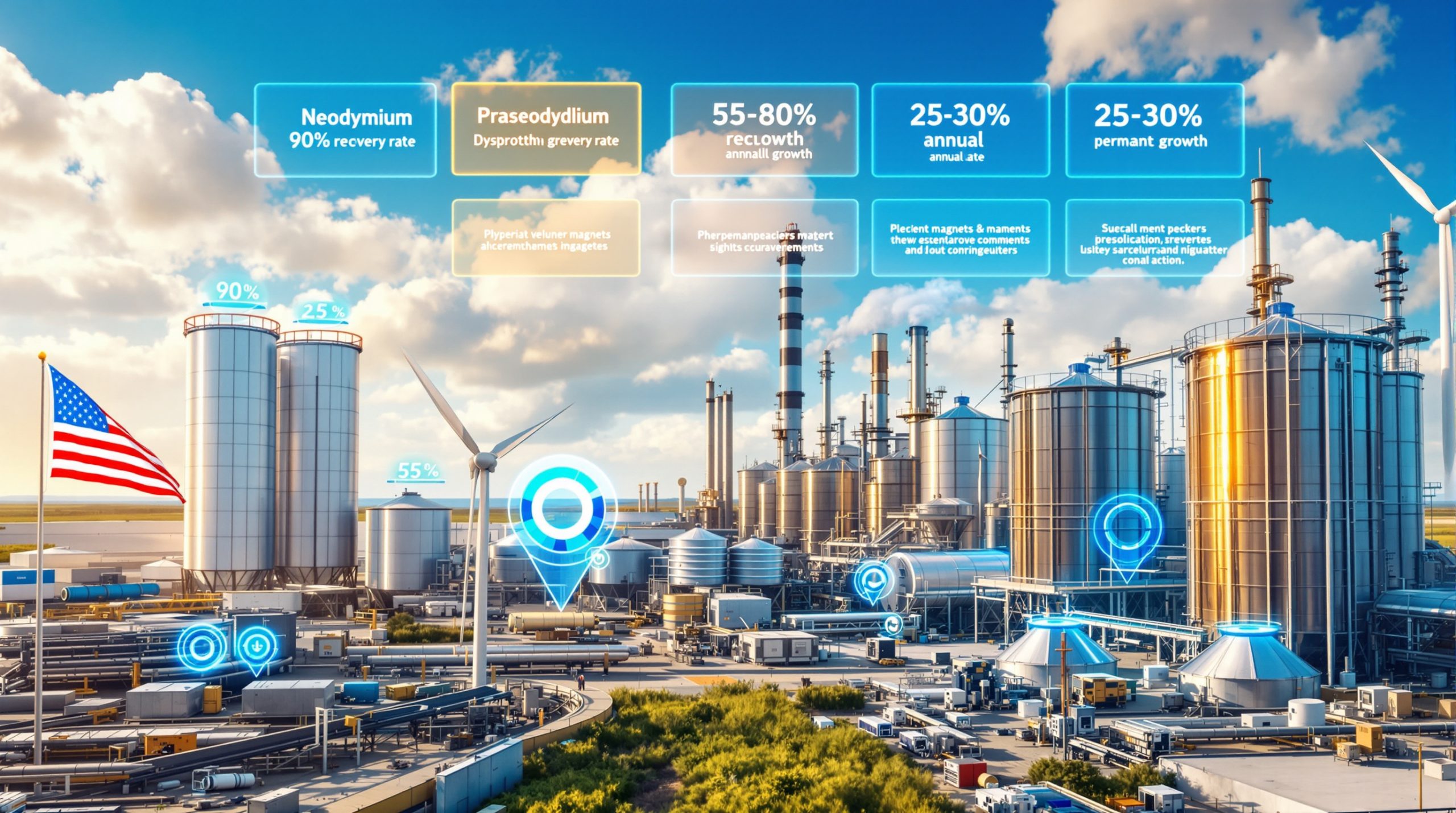The modernization of China Northern Rare Earth's facilities represents a transformative shift in global rare earth production capabilities, with comprehensive upgrades establishing new technological benchmarks for environmental sustainability, automation excellence, and strategic resource optimization. These China Northern Rare Earth modernization projects demonstrate how advanced manufacturing can address growing critical minerals demand while maintaining strict environmental compliance standards.
How Is the Green Smelting Upgrade Revolutionizing Production Methods?
Advanced Environmental Processing Technologies
The Green Smelting Upgrade Phase II represents a fundamental transformation in rare earth processing methodology, featuring comprehensive facility enhancements including specialised plant envelope systems, reinforced structural components, and advanced fire-resistant coating technologies. This modernisation initiative emphasises rigorous scheduling protocols, optimised resource allocation, and adherence to elevated safety and quality benchmarks.
The upgrade establishes new paradigms for sustainable rare earth extraction by eliminating conventional smelting inefficiencies through state-of-the-art environmental controls. Construction teams are implementing sophisticated infrastructure improvements that integrate seamlessly with existing operations while preparing facilities for next-generation production capabilities. Furthermore, these enhancements reflect broader trends in mining industry evolution toward sustainable practices.
Integrated Waste Management Systems
The modernisation incorporates comprehensive three-waste treatment protocols addressing wastewater management, atmospheric emissions control, and solid waste processing through advanced resource recovery technologies. These systems enable extensive material recycling while maintaining strict environmental compliance that surpasses international regulatory requirements.
According to research from the U.S. Geological Survey, rare earth element production historically generates substantial waste products requiring sophisticated management infrastructure. The advanced treatment systems being implemented align with broader industry trends toward environmental remediation and sustainable processing methods.
The three-waste protocol encompasses:
• Wastewater Treatment Systems – Advanced filtration and recycling mechanisms for comprehensive liquid waste management
• Atmospheric Emissions Control – Air purification technologies reducing particulate matter and volatile organic compounds
• Solid Waste Recovery – Material reclamation and resource recovery infrastructure maximising material utilisation
Environmental standards relevant to rare earth processing include the European Union's DIRECTIVE 2010/75/EU establishing Best Available Techniques for non-ferrous metal production. Additionally, China's national standards GB/T 3886 and HJ/T 195 establish comprehensive environmental protection requirements. These improvements mirror mine reclamation innovations being implemented across the industry.
What Makes the 50,000-Ton NdFeB Magnet Production Line Revolutionary?
Automated Manufacturing Excellence
The high-performance neodymium-iron-boron rapid-solidification facility represents a pinnacle of automated rare earth magnet manufacturing, integrating cutting-edge automation technologies. The installation features precision batching systems capable of ultra-accurate raw material blending across multiple input streams.
This facility, which began construction in April 2024 with trial production targeted for November 2024, incorporates Type-III continuous vacuum induction rapid-solidification furnaces. The integration includes centralised control systems and comprehensive Manufacturing Execution System information platforms.
The facility is positioned to become China's most advanced automated rare earth magnet material facility upon full operational status. The integration of automated batching capabilities with Manufacturing Execution Systems provides real-time production monitoring, quality control, and process optimisation functionality.
Production Capacity and Technology Specifications
| Specification | Details |
|---|---|
| Annual Production Capacity | 50,000 tons high-performance NdFeB alloy |
| Technology Type | Type-III continuous vacuum induction rapid-solidification |
| Construction Start | April 2024 |
| Trial Production Target | November 2024 |
| Automation Level | Fully integrated automatic batching system |
| Control Infrastructure | Centralised MES information platform |
Neodymium-iron-boron magnets constitute the strongest permanent magnets commercially available, representing approximately 30% of global rare earth demand. The rapid-solidification technology enables formation of metastable phases, allowing production of magnets with superior magnetic properties compared to conventional manufacturing methods.
The Type-III continuous vacuum induction rapid-solidification furnace technology offers several critical advantages:
• Continuous Processing – Enables uninterrupted material flow without batch cycle interruptions
• Vacuum Induction – Minimises oxidation and contamination through controlled atmospheric conditions
• Rapid Solidification – Cooling rates exceeding 1,000 K/second enable formation of fine crystalline structures
• Precision Control – Centralised systems maintain temperature and composition within narrow tolerances
Manufacturing Execution Systems implementation in magnet manufacturing typically reduces waste by 5-15% and improves throughput consistency by 8-12%. These developments align with broader decarbonisation benefits being realised across the mining sector.
How Are Capacity Expansions Strengthening Vertical Integration?
Rare Earth Metal Production Scaling
The comprehensive capacity expansion at Northern Zhongxin Antai Rare Earth demonstrates sophisticated project management through simultaneous construction methodologies. The 8,000-ton annual capacity increase will elevate total production from 7,000 tons to 15,000 tons through coordinated construction.
This expansion enables production diversification into heavier rare earth metals including gadolinium-iron compounds, addressing critical supply chain gaps. Heavy rare earth elements like gadolinium represent essential components for high-temperature magnet applications, nuclear reactor control systems, and medical imaging technologies.
| Expansion Component | Current Capacity | Post-Expansion | Percentage Increase |
|---|---|---|---|
| Annual Metal Production | 7,000 tons | 15,000 tons | +114% |
| Product Portfolio | Light rare earths | Heavy rare earths included | Expanded scope |
| Completion Timeline | N/A | Year-end 2024 | Accelerated delivery |
Circular Resource Recovery Systems
The development of a 4,000-ton NdFeB waste-recovery line establishes comprehensive recycling capabilities for magnet materials. This creates closed-loop resource utilisation that reduces dependency on primary extraction while maximising material efficiency.
This facility addresses regional processing gaps for heavy rare earth metals through the One-South, One-North resource-utilisation system approach. Additionally, Jinmeng Rare Earth has successfully commissioned a 3,000-ton-per-year rare earth concentrate separation line that entered trial operation in mid-June 2024.
Recycled NdFeB material can achieve 90-95% of virgin material performance through appropriate reprocessing, providing significant cost and energy advantages. The closed-loop approach mirrors successful implementations in Scandinavian rare earth operations and Japanese manufacturer-led magnet recycling programs.
What Strategic Advantages Does Vertical Integration Provide?
Porter's Five Forces analysis indicates that rare earth industry vertical integration provides cost reduction through elimination of intermediary margins. Furthermore, it offers quality control through direct oversight of input specifications, supply security through assured access to intermediate products, and competitive advantage through barriers to entry. These insights complement existing mineral beneficiation insights from other global markets.
What Role Does the Wet-Process Smelting Pilot Base Play?
Multi-Platform Research Integration
The wet-process smelting and inorganic functional materials pilot base represents a critical bridge between laboratory-scale research and commercial production implementation. The facility is scheduled to reach handover readiness by December 2024. This comprehensive facility integrates four specialised operational platforms designed to transition innovative processing methods into commercial viability.
The four core operational platforms encompass:
• Rare earth mineral wet-smelting operations – Primary ore processing using hydrometallurgical methods
• Comprehensive waste treatment and resource reuse systems – Three-waste management with resource recovery capabilities
• Advanced separation and purification technologies – Element isolation for high-purity production applications
• Fine chemical and powder synthesis capabilities – Value-added product manufacturing for specialised applications
Technology Transfer and Scaling Advantages
Pilot facilities serve essential infrastructure roles in rare earth processing development by enabling risk reduction through testing of new processes. They allow process optimisation through identification of inefficiencies and improvement opportunities, quality validation through confirmation of product specifications, and regulatory compliance documentation.
Wet-process (hydrometallurgical) smelting offers significant advantages over traditional pyrometallurgical methods:
| Processing Aspect | Wet-Process | Pyrometallurgical |
|---|---|---|
| Operating Temperature | Ambient to 100°C | 800-1200°C |
| Energy Consumption | Lower | Higher |
| Environmental Impact | Reduced emissions | Higher dust/emissions |
| Product Purity | High | Moderate-High |
| Initial Capital Cost | Lower | Higher |
The technology transfer from laboratory to commercial scale represents one of the largest risk factors in rare earth processing development. Pilot facilities typically require 18-36 months of operational validation before full-scale commercialisation.
Multi-platform integration benefits include shared infrastructure efficiency, reduced material handling costs, optimised water and energy consumption, and integrated waste management streams that create operational synergies.
How Do These Projects Impact Global Supply Chain Dynamics?
Strategic Market Positioning
China Northern Rare Earth modernization projects substantially strengthen China's dominant position in global rare earth processing by establishing advanced manufacturing capabilities. The integration of automation, recycling technologies, and heavy metal processing creates competitive advantages through enhanced production efficiency and reduced environmental impact.
The comprehensive project portfolio represents significant technological advancement that positions NRE among global industry leaders. With rare earth production capacity estimated at approximately 300,000-350,000 tons annually worldwide, the 50,000-ton NdFeB facility represents substantial market influence.
International Competitive Pressure
These developments create substantial pressure on Western supply chain de-risking initiatives and innovation investments. The technological sophistication and scale of NRE's projects establish new performance benchmarks that require substantial capital investment for international competitors.
According to analysis by China's Strategic Rare Earth Integration, the automation integration, environmental compliance standards, and production scaling demonstrated influence global industry standards. Western producers must match or surpass these environmental and technological achievements to remain competitive.
What Are the Critical Supply Chain Implications?
The modernisation projects enhance supply chain reliability through automated systems that reduce production variability while increasing output consistency. Advanced monitoring and control systems minimise operational disruptions that could affect global supply availability, particularly for critical applications in renewable energy and defence sectors.
What Are the Economic Implications of These Modernization Efforts?
Investment Scale and Competitive Returns
The comprehensive modernisation initiative represents substantial capital deployment across multiple production segments, with investments in automation, environmental systems, and capacity expansion. The 88% project start rate demonstrates exceptional execution capabilities and effective resource allocation across simultaneous development programs.
The economic impact extends beyond individual facility improvements to encompass supply chain integration, technology leadership, and market share consolidation. By advancing technological capabilities while expanding production capacity, NRE strengthens its position as the world's largest rare earth producer.
Market Share Consolidation Effects
The modernisation efforts consolidate China's strategic control over critical materials essential for renewable energy technologies, defence applications, and high-technology manufacturing. The expansion into heavy rare earth processing and comprehensive recycling capabilities reduces global supply diversity.
International markets must navigate increased supply concentration risks while Chinese producers benefit from economies of scale, technological advancement, and vertical integration advantages. These advantages compound over time through operational experience and continuous improvement implementations.
How Do Environmental Standards Drive Innovation?
ESG Compliance and Performance Leadership
The Green Smelting Upgrade establishes new environmental, social, and governance standards that international producers must match or exceed to remain competitive. These initiatives demonstrate how environmental requirements drive technological innovation rather than limiting production capabilities.
The comprehensive environmental management approach addresses multiple stakeholder concerns while maintaining production efficiency targets. Advanced waste treatment systems, energy-efficient processing technologies, and resource recovery mechanisms prove that sustainability and profitability align through proper technological implementation.
Sustainable Production Methods Integration
The integration of environmental compliance with operational efficiency creates sustainable competitive advantages that compound over time. Companies implementing advanced environmental technologies often achieve superior long-term cost structures through energy efficiency and waste reduction benefits.
The International Energy Agency identifies rare earth element production efficiency as critical to renewable energy supply chains. Modernised smelting operations reduce energy consumption per unit by 20-40% through automation and process optimisation.
What Does This Mean for Future Rare Earth Supply Security?
Production Reliability and Consistency Enhancement
The modernisation projects enhance global supply chain reliability through automated systems that reduce production variability while increasing output consistency. Advanced monitoring and control systems minimise operational disruptions that could affect international supply availability, particularly for critical applications requiring consistent material specifications.
The facility upgrades address historical supply chain vulnerabilities through redundant processing capabilities, advanced quality control systems, and comprehensive waste recovery. These improvements create more predictable supply patterns for downstream industries dependent on rare earth inputs.
Strategic Resource Control Implications
By expanding processing capabilities for both light and heavy rare earth elements, NRE strengthens China's strategic control over materials essential for renewable energy infrastructure. The integration of recycling capabilities with primary production reduces global supply diversity while increasing efficiency of resource utilisation.
The comprehensive modernisation approach creates strategic advantages that extend beyond simple production capacity to encompass technological leadership, environmental compliance, and supply chain integration capabilities. These require substantial time and capital investments for international competitors to replicate.
Disclaimer: The information presented in this analysis is based on publicly available reports and industry research. Market conditions, technological developments, and competitive dynamics in the rare earth industry are subject to rapid change. Readers should conduct independent research and consult with qualified professionals before making investment or business decisions.
China Northern Rare Earth modernization projects represent a paradigm shift in global rare earth production standards, combining advanced automation, environmental sustainability, and strategic resource optimisation. The successful implementation of 30 projects with an 88% start rate demonstrates exceptional execution capabilities while creating technological advantages that will influence international supply chain dynamics.
These developments highlight the critical importance of technological innovation in maintaining market leadership while addressing environmental responsibilities and supply chain security concerns. As international competitors work to establish alternative supply sources and processing capabilities, NRE's modernisation efforts continue setting increasingly sophisticated standards for production efficiency and environmental compliance throughout the global rare earth industry.
Are You Positioned to Capitalise on Critical Minerals Opportunities?
Discovery Alert's proprietary Discovery IQ model delivers instant notifications on significant ASX mineral discoveries, including critical minerals essential for renewable energy technologies and advanced manufacturing. Stay ahead of major resource discoveries that could drive substantial market movements by exploring Discovery Alert's comprehensive discoveries page and begin your 30-day free trial today.




